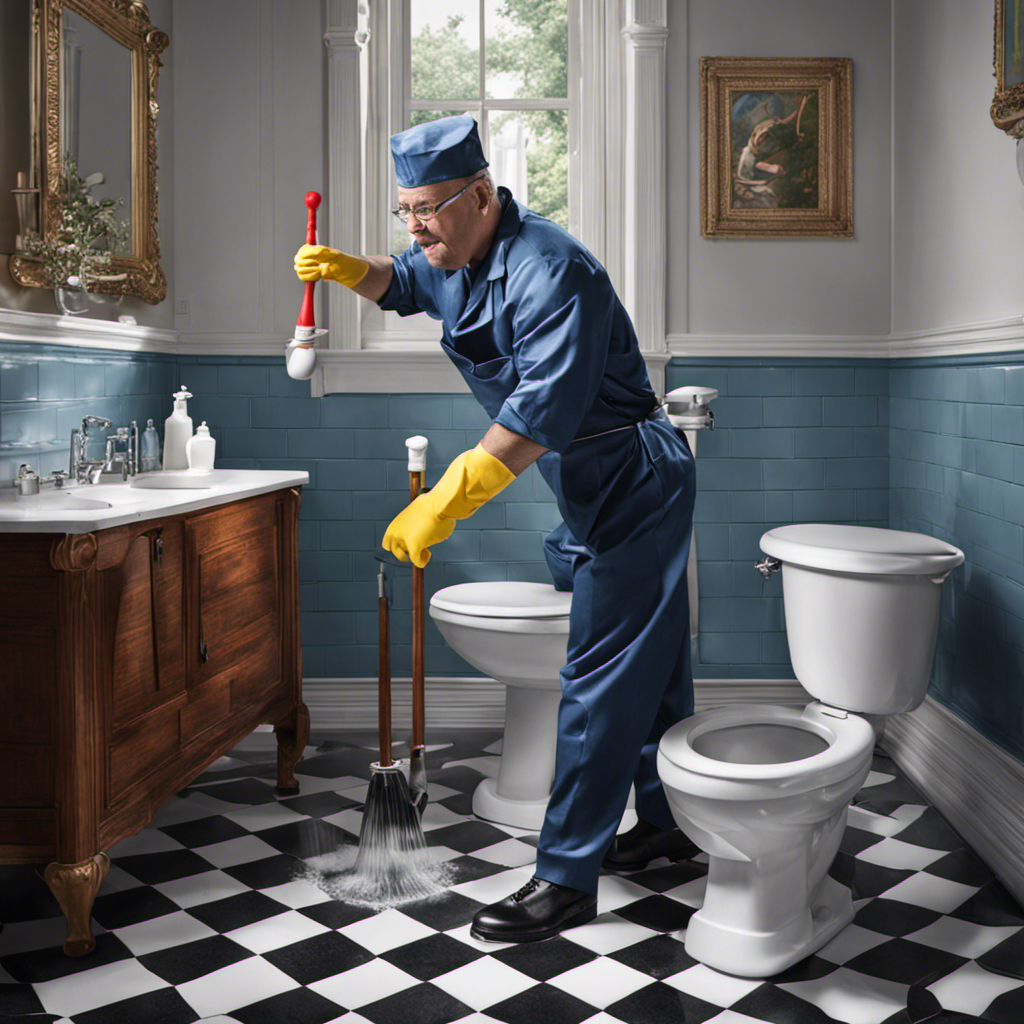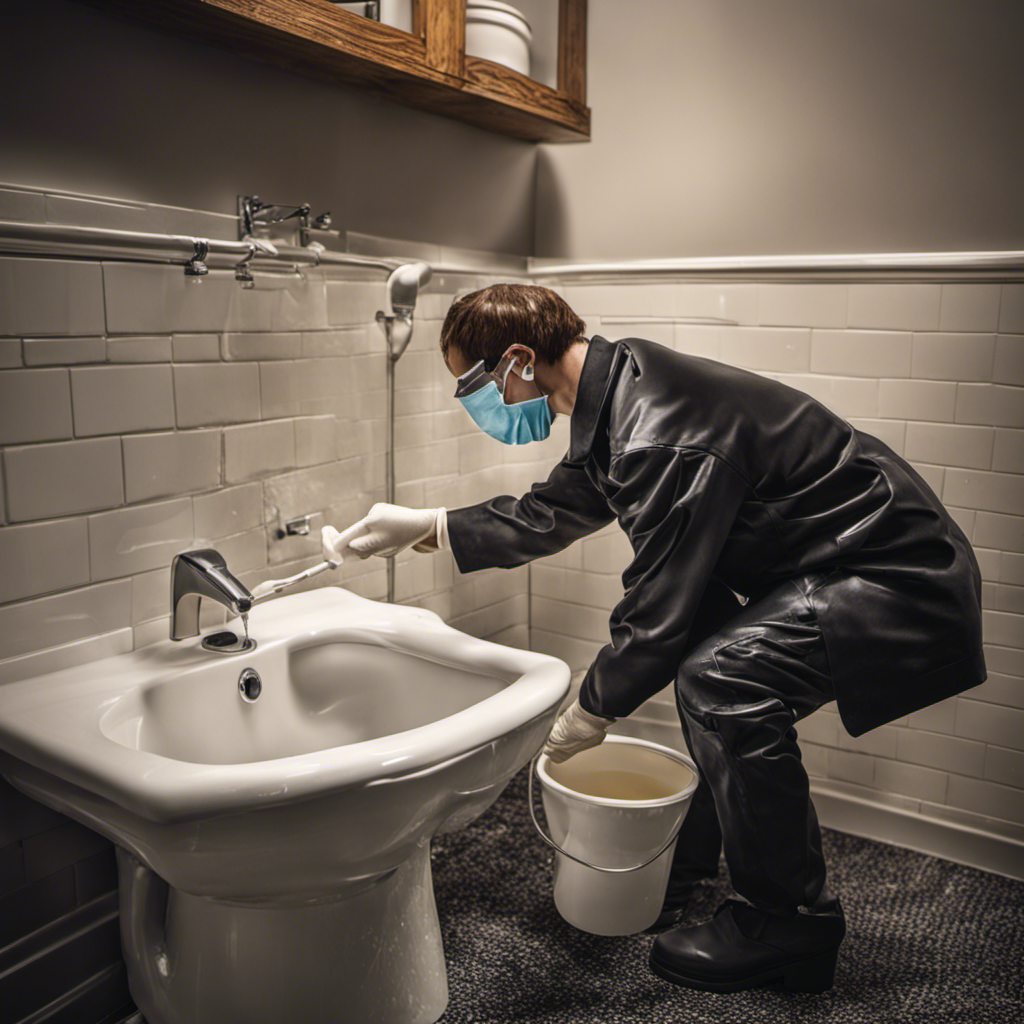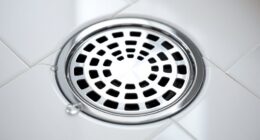When faced with a clogged toilet filled with feces, one must act swiftly to avoid a messy situation.
This comprehensive guide offers effective methods for unclogging toilets using common household tools and techniques.
From the trusty plunger to the versatile toilet auger, there are various options to tackle the issue head-on.
With the use of hot water and dish soap or even chemical drain cleaners, individuals can regain their sanity and restore functionality to their toilets.
By being prepared and armed with the right knowledge, one can confidently address and resolve this common bathroom predicament.
Key Takeaways
- Plumbing snakes, plungers, chemicals, and household products are effective tools for unclogging a toilet with poop.
- It is important to choose the right method and use it correctly to efficiently clear the obstruction.
- Being prepared for future clogs and knowing how to handle them can save time and prevent further issues.
- Safety precautions such as wearing rubber gloves and avoiding splashing should be followed when using these methods.
Tools for Unclogging a Toilet
Plumbing snakes, plungers, chemicals, and everyday home products such as baking soda are all useful tools for unclogging a toilet. However, for those seeking toilet snake alternatives or natural remedies for unclogging toilets, there are other options available.
One alternative is using a toilet brush to manually break up the clog. This method requires inserting the brush into the toilet bowl and vigorously moving it back and forth to dislodge the obstruction.
Another natural remedy involves using a mixture of hot water and vinegar. By pouring a combination of equal parts hot water and vinegar into the toilet bowl, the acidic properties of the vinegar can help dissolve the clog.
These alternatives provide solutions for those who prefer more natural or DIY approaches to unclogging their toilets.
Using a Plunger
To avoid splashing, the user should lift the toilet seat before placing the plunger in the bowl and covering the drain completely.
Using a plunger is a common and effective method for unclogging a toilet. The pros of using a plunger are that it is easy to use and doesn’t require any chemicals or special tools. It creates suction to dislodge the clog and allows for a quick fix.
However, there are some cons to using a plunger. It may not be effective for stubborn or larger clogs, and there is a risk of splashing if not used properly.
Common mistakes to avoid when using a plunger include not covering the drain completely, not applying enough force, and not standing at a safe distance to prevent splashing.
Using a Toilet Auger
The user can feed the metal end of a toilet auger into the toilet and push in and out to break up the blockage. This tool is highly effective in clearing stubborn clogs caused by solid waste.
To use a toilet auger effectively, follow these tips for safe operation:
- Ensure the toilet seat is lifted to avoid splashing.
- Slowly insert the metal end of the auger into the toilet drain.
- Apply gentle pressure while pushing and pulling the auger to break up the blockage.
- If you encounter resistance, pull out slightly and continue the process.
- After each attempt, try flushing the toilet to check if the clog has been cleared.
- Repeat the process until the clog is fully resolved.
Using a toilet auger requires caution to prevent damage to the toilet bowl or injury. By following these guidelines, users can effectively utilize this tool to unclog their toilets safely and efficiently.
Using a Clothes Hanger
Using a wire clothes hanger is one of the alternative methods for unclogging a toilet with poop. The user can unwind it completely and feed one end into the toilet to break up the clog.
The pros of using a clothes hanger are its accessibility and affordability. Most households have a wire hanger readily available, making it a convenient tool to use in case of an emergency. Additionally, it is a cost-effective option compared to purchasing specialized tools.
However, there are also cons to consider. Using a clothes hanger may scratch the toilet bowl if not used with caution. It may also not be as effective in breaking up stubborn clogs compared to other tools such as a plunger or a plumbing snake.
Therefore, while a clothes hanger can be a quick fix, it may not always be the most efficient method for unclogging toilets with poop.
Using Hot Water and Dish Soap
Pouring a mixture of boiled water and dish soap into the toilet bowl can help soften up the waste and break it up for easier flushing. This method has its pros and cons when it comes to unclogging a toilet with poop.
Pros:
- The hot water and dish soap mixture can effectively soften and break up the waste, making it easier to flush.
- It is a simple and inexpensive method that uses everyday household items.
Cons:
- It may not be as effective for severe clogs or large amounts of waste.
- The mixture may not completely dissolve the poop, requiring additional methods or tools.
Common mistakes to avoid when using hot water and dish soap for unclogging a toilet with poop:
- Pouring the mixture too quickly, causing splashing and making a mess.
- Not letting the mixture sit for the recommended time, which may not fully soften the waste.
- Flushing the toilet before the waste is significantly broken up, leading to further clogging.
Remember to exercise caution and consider other methods if the clog persists.
Additional Methods
Hot water and dish soap can be effective in breaking up toilet clogs caused by waste. However, there are also additional methods that can be used for toilet clog prevention and natural DIY toilet cleaners.
One option is to use household bleach. Simply pour two cups of bleach into the toilet bowl, let it sit for 10-15 minutes, and then flush.
Another method involves using hot water and shampoo. Pour 3 cups of hot water and 8-10 oz of shampoo into the toilet bowl, let it sit for 15-30 minutes, and then check if the clog has moved.
Chemical drain cleaners, whether commercial or enzyme-based, can also be utilized to dissolve waste.
These additional methods provide alternative solutions for unclogging toilets and offer natural DIY options for those who prefer to avoid harsh chemicals.
Conclusion
After exploring additional methods for unclogging a toilet with poop, it is important to consider the pros and cons of using chemical drain cleaners.
Pros of Chemical Drain Cleaners:
- They are readily available and easy to use.
- They can dissolve tough clogs quickly and effectively.
- Some drain cleaners contain enzymes that can break down organic waste.
Cons of Chemical Drain Cleaners:
- They can be harmful to the environment and human health.
- Chemical drain cleaners may damage pipes and plumbing fixtures if used incorrectly.
- They can be expensive, especially if multiple applications are needed.
To prevent future toilet clogs, there are a few simple steps to follow:
-
Regular maintenance: Use a toilet brush to clean the toilet bowl regularly to prevent buildup.
-
Proper waste disposal: Avoid flushing items that can cause clogs, such as sanitary products, wipes, or excessive amounts of toilet paper.
-
Water conservation: Ensure the toilet has enough water pressure to flush waste effectively.
-
Professional inspection: Periodically have a plumber inspect the toilet and plumbing system to identify and address any potential issues before they become major problems.
Tips for Future Clogs
To prevent future clogs, individuals can implement simple steps to maintain their toilets and plumbing systems.
Maintaining toilet hygiene is crucial for preventing clogs and ensuring proper functioning. Regularly cleaning the toilet bowl and removing any debris or buildup can help prevent blockages. Using a toilet brush to scrub the bowl and flush it thoroughly can keep the pipes clear.
Additionally, avoiding flushing items that are not meant to be flushed, such as wipes, feminine hygiene products, or excessive amounts of toilet paper, can prevent clogs.
It is also important to be mindful of what goes down the drains in the bathroom, such as hair or soap residue, as these can contribute to clogs in the plumbing system.
Frequently Asked Questions
Can a Toilet Brush Be Used to Unclog a Toilet With Poop?
Yes, a toilet brush can be used to unclog a toilet with poop. It can help break up the blockage when inserted and twisted. However, using a plunger effectively is generally a more recommended method.
Are There Any Risks Involved in Using Chemical Drain Cleaners?
Using chemical drain cleaners to unclog toilets with poop can have potential side effects, such as damage to pipes and harmful fumes. Alternatives like plungers, snakes, and natural products like baking soda are safer options.
What Should I Do if None of the Mentioned Methods Work in Unclogging the Toilet?
If none of the mentioned methods work in unclogging the toilet, there are alternative solutions. One option is to call a plumber who has the expertise and tools to resolve the issue effectively.
Can Using Hot Water and Dish Soap Damage the Toilet Bowl?
Using hot water and dish soap to unclog a toilet with poop is generally safe for the toilet bowl. However, excessive heat may cause damage, so it’s important to use hot water within a reasonable range. There are alternative cleaning methods available as well.
Are There Any Preventive Measures to Avoid Future Toilet Clogs?
Toilet clog prevention and proper toilet maintenance are essential for avoiding future clogs. Simple measures like regular cleaning, avoiding flushing non-flushable items, and using a toilet paper in moderation can help maintain a healthy and functioning toilet.
Conclusion
In conclusion, having the knowledge and tools to unclog a toilet with feces can save you time and frustration.
Imagine this: you’re hosting a dinner party and your toilet suddenly becomes clogged with poop. It’s a messy situation, but fear not! Armed with a plunger or toilet auger, you can tackle the problem head-on and restore order to your bathroom.
Remember, prevention is key, so be mindful of what you flush. With these effective methods at your disposal, you’ll be able to handle any future clogs with ease.
Stay prepared and keep those toilets flowing smoothly!










